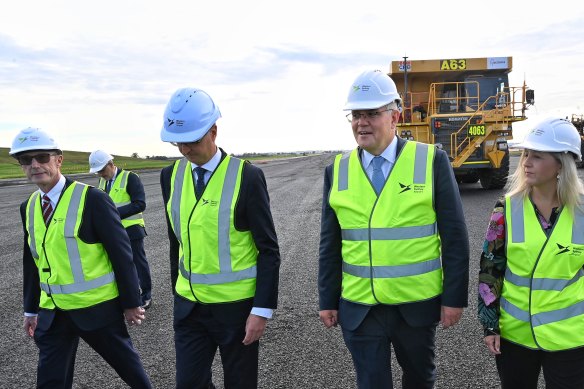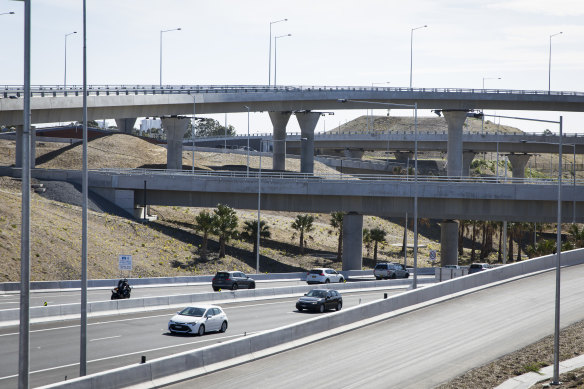This was published 3 years ago
Opinion
Right on cue, politicians’ worrying addiction on show
Marion Terrill
Transport and cities program director at Grattan InstituteFederal budgets aren’t the great unveiling they used to be. We already know that Victoria is set to receive $3.3 billion in transport infrastructure funding in the 2022 budget. The federal government hopes this will be a vote-winner when the official election campaign begins.
But, yet again, the government is jumping the gun, committing to spending big bucks before establishing whether these are good projects and now is the right time to build them.

Prime Minister Scott Morrison.Credit: Nick Moir
Ahead of budget night, the government has revealed it will spend an additional $16.5 billion on transport, and 20 per cent of that will be in Victoria – home to 26 per cent of the nation’s population and a similar share of the nation’s passenger and freight traffic.
Meanwhile, Queensland – with 20 per cent of the nation’s population – is in line for 24 per cent of the dollars – again.
Grattan Institute research shows there’s been a persistent pattern over 18 years of sending more transport dollars to Queensland and NSW, where federal elections tend to be won and lost.
Most of the spend in Victoria will be on the new intermodal freight terminals being planned for Beveridge in Melbourne’s north and Truganina in the west. These terminals are where goods are transferred between road and rail. They’ll be connected to the Port of Melbourne and to the Inland Rail freight line between Melbourne and Brisbane.
But the Melbourne Intermodal Terminal project simply isn’t ready for this commitment. Even though this budget will pile a further $3.1 billion on top of the $2 billion in last May’s budget, there isn’t a finalised business case yet.
This is muddled thinking: the business case is supposed to come before, not after, the decision to invest. The business case is a tool to help governments decide whether or not the proposed project is worth building, and whether it’s the best option to solve the problem.
It’s just a taster for the election campaign. In the lead-up to the 2019 federal election, only one of the Coalition’s 71 promised transport projects valued at $100 million or more had a business case approved by Infrastructure Australia, while for Labor, it was two projects of 61.
And at the election before that, in 2016, only four of the Coalition’s 21 promised projects had an approved business case, and for Labor, just one of 28.

In the lead-up to the 2019 federal election, only one of the Coalition’s 71 promised transport projects valued at $100 million or more had a business case approved by Infrastructure Australia, while for Labor, it was two projects of 61.Credit: Anna Kucera
The government will argue that the intermodal terminal is going to be needed to take full advantage of Inland Rail. Due for completion in 2025, Inland Rail will run from Melbourne to Brisbane and handle double-stacked 1.8km-long trains.
The Inland Rail project is riddled with risk. It was first costed at $4.4 billion by the Australian Rail Track Corporation in 2010; by 2015, the cost estimate had ballooned to $9.9 billion, with only the skinniest of margins to suggest it might be worth building.
Next, in December 2020, the government announced the cost had exploded to $14.5 billion. Last we heard, Deputy Prime Minister Barnaby Joyce has decided it needs to go an extra 500 kilometres, to Gladstone, for a further $5 billion of taxpayers’ money – so far.
The federal government is also going again on commuter carparks, even after being burnt with cancellations around Melbourne due to station closures, lack of suitable site or design options, and community opposition. The 2022 budget will include $18 million for a commuter carpark at Kananook on the Frankston line, and a further $8.5 million at Hampton.
The government seems to be overlooking just how heated the engineering construction sector is. Even before the pandemic, there had been a surge in government road and rail building, with the value of work under construction exceeding $120 billion for the first time ever in March 2020.
The amount of road and rail work being completed has barely slowed during the pandemic, and there’s been stiff competition for specialist skills and equipment for the massive projects that government now favour. The sector is pleading with government for consideration of cost rises in timber, steel, concrete and fuel. Putting more work into an already heated market just pushes up prices.
Whichever party wins the 2022 federal election should strengthen the transport spending guardrails. Rather than making promises on the hoof, they should require consideration and publication of the business case, cost-benefit analysis, and project priority before they commit public money.
And no more carparks and other small hyper-local projects.
The last word should go to outgoing federal Liberal member for the Sydney seat of Bennelong, John Alexander, who on Sunday called on Australia’s politicians to overcome their addiction to using infrastructure spending to buy votes.
Marion Terrill is the transport and cities program director at the Grattan Institute.